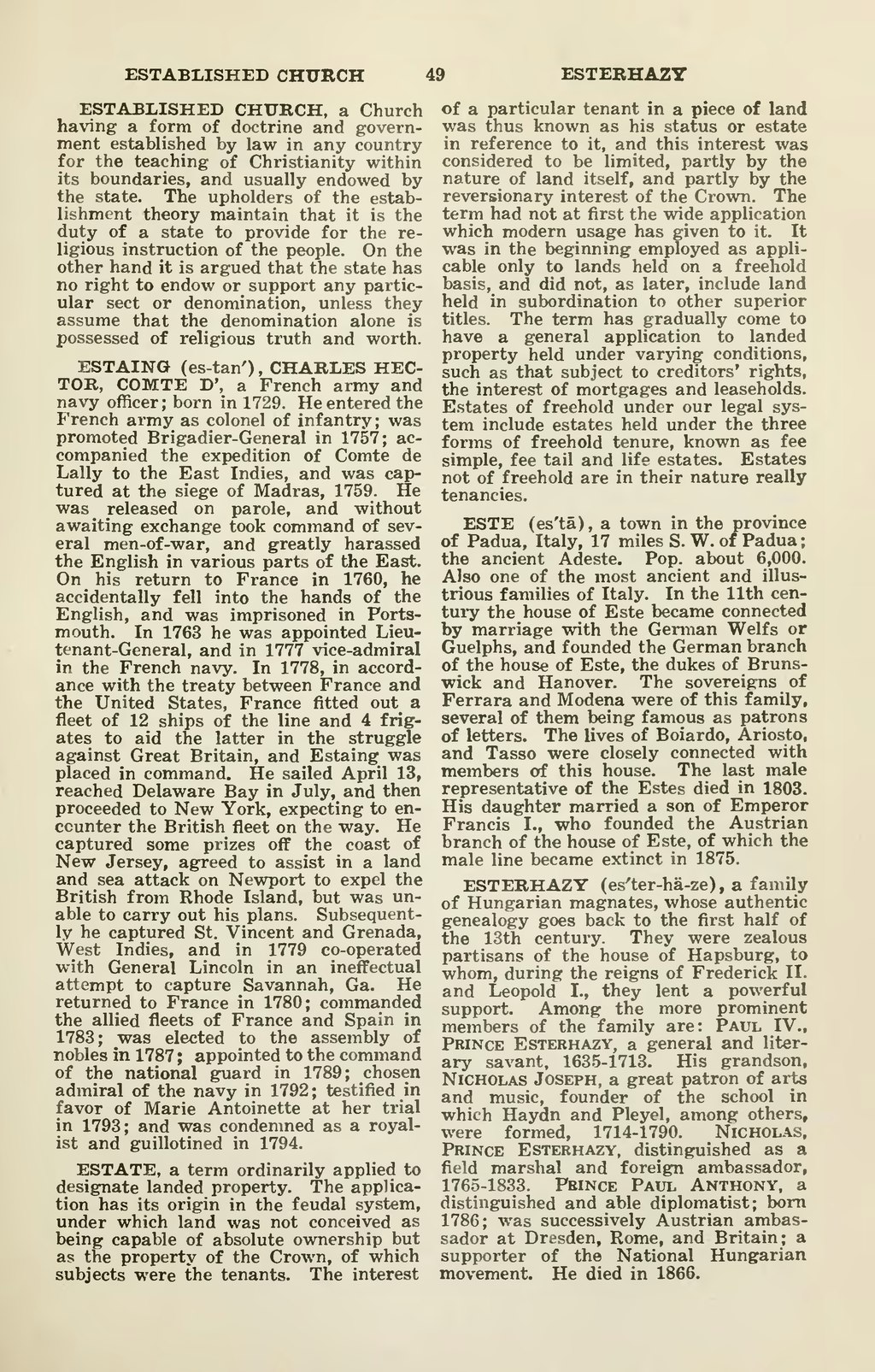ESTABLISHED CHURCH 49 ESTERHAZY ESTABLISHED CHURCH, a Church having a form of doctrine and govern- ment established by law in any country for the teaching of Christianity within its boundaries, and usually endowed by the state. The upholders of the estab- lishment theory maintain that it is the duty of a state to provide for the re- ligious instruction of the people. On the other hand it is argued that the state has no right to endow or support any partic- ular sect or denomination, unless they assume that the denomination alone is possessed of religious truth and worth. ESTAING (es-tanO , CHARLES HEC- TOR, COMTE D', a French army and navy officer; born in 1729. He entered the French army as colonel of infantry; was promoted Brigadier-General in 1757; ac- companied the expedition of Comte de Lally to the East Indies, and was cap- tured at the siege of Madras, 1759. He was released on parole, and without awaiting exchange took command of sev- eral men-of-war, and greatly harassed the English in various parts of the East. On his return to France in 1760, he accidentally fell into the hands of the English, and was imprisoned in Ports- mouth. In 1763 he was appointed Lieu- tenant-General, and in 1777 vice-admiral in the French navy. In 1778, in accord- ance with the treaty between France and the United States, France fitted out^ a fleet of 12 ships of the line and 4 frig- ates to aid the latter in the struggle against Great Britain, and Estaing was placed in command. He sailed April 13, reached Delaware Bay in July, and then proceeded to New York, expecting to en- counter the British fleet on the way. He captured some prizes off the coast of New Jersey, agreed to assist in a land and sea attack on Newport to expel the British from Rhode Island, but was un- able to carry out his plans. Subsequent- ly he captured St. Vincent and Grenada, West Indies, and in 1779 co-operated with General Lincoln in an ineffectual attempt to capture Savannah, Ga. He returned to France in 1780; commanded the allied fleets of France and Spain in 1783; was elected to the assembly of nobles in 1787 ; appointed to the command of the national guard in 1789; chosen admiral of the navy in 1792; testified in favor of Marie Antoinette at her trial in 1793; and was condemned as a royal- ist and guillotined in 1794. ESTATE, a term ordinarily applied to designate landed property. The applica- tion has its origin in the feudal system, under which land was not conceived as being capable of absolute ownership but as the property of the Crown, of which subjects were the tenants. The interest of a particular tenant in a piece of land was thus known as his status or estate in reference to it, and this interest was considered to be limited, partly by the nature of land itself, and partly by the reversionary interest of the Crown. The term had not at first the wide application which modern usage has given to it. It was in the beginning employed as appli- cable only to lands held on a freehold basis, and did not, as later, include land held in subordination to other superior titles. The term has gradually come to have a general application to landed property held under varying conditions, such as that subject to creditors' rights, the interest of mortgages and leaseholds. Estates of freehold under our legal sys- tem include estates held under the three forms of freehold tenure, known as fee simple, fee tail and life estates. Estates not of freehold are in their nature really tenancies. ESTE (es'ta) , a town in the province of Padua, Italy, 17 miles S. W. of Padua ; the ancient Adeste. Pop. about 6,000. Also one of the most ancient and illus- trious families of Italy. In the 11th cen- tury the house of Este became connected by marriage with the German Welfs or Guelphs, and founded the German branch of the house of Este, the dukes of Bruns- wick and Hanover. The sovereigns of Ferrara and Modena were of this family, several of them being famous as patrons of letters. The lives of Boiardo, Ariosto, and Tasso were closely connected with members of this house. The last male representative of the Estes died in 1803. His daughter married a son of Emperor Francis I., who founded the Austrian branch of the house of Este, of which the male line became extinct in 1875. ESTERHAZY (es'ter-ha-ze) , a family of Hungarian magnates, whose authentic genealogy goes back to the first half of the 13th century. They were zealous partisans of the house of Hapsburg, to whom, during the reigns of Frederick II. and Leopold I., they lent a powerful support. Among the more prominent members of the family are: Paul IV., Prince Esterhazy, a general and liter- ary savant, 1635-1713. His grandson, Nicholas Joseph, a great patron of arts and music, founder of the school in which Haydn and Pleyel, among others, were formed, 1714-1790. Nicholas, Prince Esterhazy, distinguished as a field marshal and foreign ambassador, 1765-1833. Prince Paul Anthony, a distinguished and able diplomatist; bom 1786; was successively Austrian ambas- sador at Dresden, Rome, and Britain; a supporter of the National Hungarian movement. He died in 1866.
Page:Collier's New Encyclopedia v. 04.djvu/67
This page needs to be proofread.
LEFT
49
RIGHT
